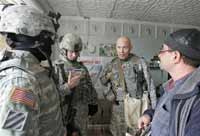US Army Human Terrain System in Disarray
Millions of Dollars Wasted, Two Lives Sacrificed*

by John Stanton
According to sources, United States Army brigade commanders privately believe that the US Army's TRADOC Human Terrain System (HTS) program is a “joke” and completely unnecessary. The HTS program is publicly supported by brigade military commanders, and Secretary of Defense Robert Gates, only because it is a “pet project” of the currently politically popular US Army General David Petraeus.
BAE Systems, the prime contractor on the project, has repeatedly been pressured by the HTS program manager and his staff to hire individuals who are not field-experienced ethnographers/anthropologists, but rather Google-fed political and social scientists. In two cases, pre-security clearance award investigations revealed that one candidate recommended for hire by senior staff was a felon. The other candidate had health problems that would have compromised the functions of a deployed Human Terrain Team (HTT). BAE Systems has been the punching bag for the poor decision making of HTS program managers and advisors.
The tragic deaths of two HTS members--HTT IZ3 Nicole Suveges and HTT AF1 Michael Bhatia---came amidst program management’s confusion over roles and missions, ignorance of threat situations, even dress code problems. Key questions remain open. What’s the role of a civilian ethnographer/anthropologist working with the military in a combat zone? Is a civilian trained to respond to a threat without threatening the life of the team? Should they carry weapons and wear military gear? Are they there to enhance the kill chain, organize and facilitate sporting events, or examine trash dumps for behavioral patterns? What kind of data do warfighters and negotiators really want? What happens when the HTT leaves the site of success? What's the historical experience of the US military with human geographers? (see David Price—Anthropolgical Intelligence: The Deployment and Neglect of American Anthropology in the Second World War: Duke University Press, 2008).
Whether all this mattered in the deaths of Suveges and Bhatia is utterly debatable. But according to sources, Suveges was a no-show at many training sessions at Fort Leavenworth and not properly trained for work in a combat zone. She was sent initially to the United Kingdom to recruit there for the HTS program and then afterwards was ultimately deployed to the volatile Sadr City in Iraq where three weeks later she met her end. One insider had predicted prior to her death that “someone was going to get killed.”
One of the HTS prime movers, TRADOC HTS Senior Social Scientist, Mrs. Montgomery McFate (Phd, JD), took a seven month sabbatical on the eve of the first deployment of the HTT’s to Iraq in 2007. Whatever guidance she had to offer the fledgling HTT's would have to wait months ‘til her sabbatical ended. Not bad for a $200,000 base salary and $200,000 in overtime, according to reports.
Allegations of HTS members plagiarizing Defense Intelligence Agency reports and articles from anthropology-specific blogs have been made. Remotely using search engines/databases and attending conferences to troll for HTS-related data, and passing that off as legitimate field data, are also alleged. HTS program funds may also have been used to allow participants to gain advanced degrees.
At the helm of it all is program manager Steve Fondacaro who has been described as a “great used car salesman” but not interested in programmatic details. One of his current goals is to market the HTS program to the controversial AFRICOM project and keep the funding alive. But his task will be difficult. On his watch the Pentagon/taxpayers lost $15 million on the MAP HT software/hardware effort. The MAP HT software/hardware apparently sits unusable with the blue wiring connections still hanging from shelves where the system was to have been housed and operated.
Sources indicate that sexual dalliances, falsified leave forms, crony no-bid contracts to Fondacaro colleagues (one in which deliverables were not fully provided), and verbal harassment of civilian staff have compromised the US Army's TRADOC program. The hiring of a former Lincoln Group strategic communications specialist to handle public relations is a sure sign of trouble.
Worse still, the reach-back center at Fort Levanworth remains understaffed. According to a source, the staff is “in a pinch” because Fondacaro is alleged to have used billets meant for reach-back operations to hire non-essential staff. Reach-back staff at Fort Leavenworth and HTT members in the field “do not communicate”, according to reports.
It is not clear whether Secretary Gates or General Petraeus are aware of these problems but they should be. Warfighters in the battlespace should not have to spend their time babysitting those who have an itch to play Army or engage in a proof-of-concept program that has, in one form or another, been behind every US attempt to colonize and/or subdue an intransigent population since the nation's founding. While the funding for the HTS program is not large, mere millions, that money could be used to enhance training for Special Operations fighters or even buy better equipment for them. America's uniformed soldiers have been experimented with and on--whether via faulty national security policy and tactics or recycled physical and social science-- for the last eight years. That's enough!
John Stanton
Subscribe to Pravda.Ru Telegram channel, Facebook, RSS!





